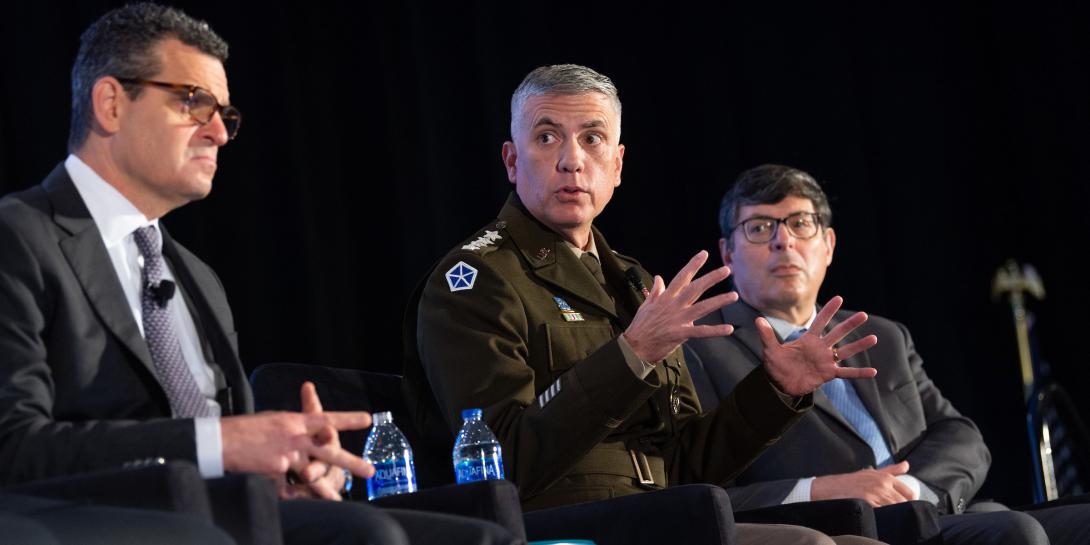Election Interference Attempts Come from More Countries Than Just Russia
The cyber activities of Russia to try and impact the U.S. presidential elections of 2016 and 2020 are well known, spoken about by U.S. military cyber and other leaders. Going forward toward the mid-term election of 2022, the roster of countries attempting to harm U.S. processes is growing, reports Gen. Paul Nakasone, USA, commander, U.S. Cyber Command. And the command is already preparing to protect the 2022 elections.
“What has changed with influence in regard to the elections, first of all, there is more than one adversary,” the cyber commander stated. “It began with just the Russians, and now it is the Russians, the Chinese, the Iranians, it is a number of different actors,” Gen. Nakasone said. “In terms of 2022, our focus right now is obviously being able to generate the insights of what adversaries are doing and who might be doing that. [That focus] will move very, very quickly to being able to share that information with a broad range of partners.”
Gen. Nakasone, who is also the director of the National Security Agency and chief of the Central Security Service, spoke yesterday at AFCEA International and INSA’s 2021 Intelligence and National SecuritySummit, held in National Harbor, Maryland.
Working with the FBI, the Cyber Information Security Agency (CISA) and other agencies on 2020 election cybersecurity proved crucial in having a “significant impact” against these adversaries’ attempts to impact the election, and this model will service as how the government and military cyber leaders work together to protect the 2022 elections—and beyond.
“You may recall that the Tuesday before the election in 2020, the director of national intelligence [John Ratcliffe] and the director of the FBI [Christopher Wray] talking about threats from Iran publicly,” the commander shared. “This is the type of work that we are going to be doing, I think for quite some time in the election space.”
Gen. Nakasone (l) @USArmy commander US Cyber: cyber security is National security. And we are very good collaborators but we have to be even more effective outside of the #IC and military and the US. #IntelSummit21 @AFCEA @INSAlliance pic.twitter.com/eLwsTtkKmG
— Kimberly Underwood (@Kunderwood_SGNL) September 14, 2021
Moreover, those same actors are trying to circumvent the success U.S. vaccines have had in protecting Americans and how the nation is addressing the pandemic through their digital disinformation campaigns.
“Let's take a look at what adversaries have been doing to try to impact or influence a narrative that is perhaps going against the impact of what our vaccines might be able to do in terms of being able to impact this global pandemic,” he said. “We are seeing the Chinese in that realm. And we are seeing the Chinese work against a number of our allies, like [trying to influence] Australian public opinion within Australia, or in the the southwest Pacific region.”
Further investments in partnerships across the government, the intelligence community and with like-minded nations on an international scale are a salve against malicious cyber activities, the commander continued. “One year ago, we released [an alert] about Drovorub with the Federal Bureau of Investigation,” he stressed. “Drovorub was the [Linux-based] ‘Swiss army knife of malware’ that the Russian military, the GRU, was using,” he stated. “Being able to release that publicly with our friends at the bureau, that is like an inoculation across that entire information technology community.”
The commander also confirmed that the Cyber Command was still certainly examining the cyber activities of terrorists, despite the move to make near-peer competition a priority under the National Defense Strategy. The command has shifted “Joint Task Force areas to a broader focus on our near-peer competitors in terms of what they're doing,” the general clarified, but noted that the command’s cyber activities would continue to involve various threats.
“We haven't taken the ball off of what violent extremist organizations are doing,” Gen. Nakasone stated. “And in fact, I would tell working with the FBI, working with our partners at the agency [CIA], this is something that we're very, very familiar with.”
The general is looking at how to engage differently with the private sector and foreign partners working on their own cybersecurity. And he is bridging new ties with U.S. cyber leaders newly in place at their posts, including CISA’s director, Jennifer Easterly, and Chris Inglis, the national cyber director. “Our strategic environment is collaboration,” Gen. Nakasone emphasized. “It shouldn't come as any surprise that we are really good collaborators. We work really effectively with all of our partners here, but we live in an environment today that we have to be even more effective outside of even the IC and the interagency.”
Lastly, like other leaders in cybersecurity, he knows that the threats will not cease.
“With cybersecurity, [look at] what has our nation faced in the last nine months: SolarWinds, Hafnium, JBS, Colonial Pipeline, ransomware and supply chain attacks,” Gen. Nakasone said. “Cybersecurity is national security. We strongly believe that. We also believe that cybersecurity leads to a new strategic environment of competition. Competition in the sense of our adversaries, near-peer adversaries, that are looking at being able to operate below the level of armed conflict to do a number of different activities, conducting strategic campaigns against our nation in areas such as cyber security or influence or other areas that impact our economy.”






Comments